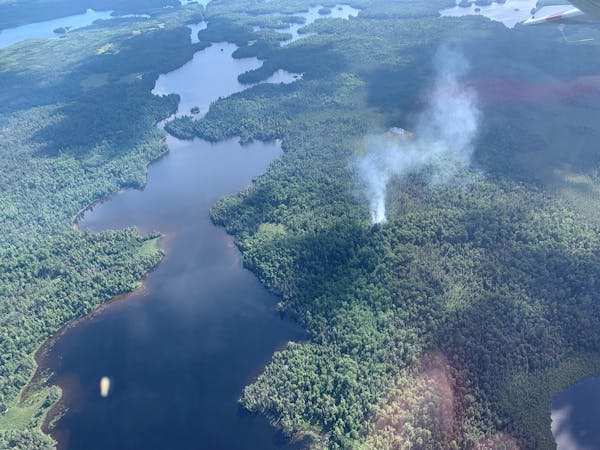Boaters are hitting rocks in the Mississippi River. Livestock farmers are seeking emergency waivers to graze cattle on conservation land. Homeowners cringing at toasted lawns are bracing for watering restrictions — if they aren't already in place.
Meanwhile, more of the Boundary Waters Canoe Area Wilderness has closed down as wildfires burning in Quetico Provincial Park across the border in Canada threaten to spread.
With about half of Minnesota now in the grip of severe drought — and 4% in extreme drought — the state has officially shifted into the "drought warning phase," the state Department of Natural Resources (DNR) announced Friday. The deepening drought is turning the summer into a sobering lesson in resource conservation.
"This is time to remind ourselves about how valuable water is," said Randall Doneen, the DNR's manager of conservation assistance and regulations.
"It really doesn't look like there's any immediate relief," Doneen said. "It would take a lot of rain to get caught up."
Invoking the state's official drought plan, the DNR has called for significant reductions in water demand. For public water suppliers, the goal is to cut summer use to 50% above January levels — a serious challenge for some communities.
The state's drought task force is also convening July 21 for the first time in nearly a decade. The group includes officials from state and federal agencies and tribal governments to coordinate drought response.
Doneen announced the changes in a two-page letter sent Friday to water suppliers in some 600 communities around the state, including most of the Twin Cities.
Significant cuts in water use can be made, the letter says, by "restricting or banning nonessential outdoor water use, especially lawn irrigation, power washing buildings, car washing and swimming pool filling."
In an interview, Doneen said underground aquifers, the source of water for most Minnesotans, are stressed because not all are able to recharge fast enough. He said the DNR has had a surge in well interference complaints in the last few weeks, many from families and small communities having problems with their water supply. Some are in heavy agriculture areas, he said.
Gov. Tim Walz has asked the U.S. Department of Agriculture to allow emergency haying and grazing on Conservation Reserve Program acres in certain Minnesota counties.
"As you are aware, the cattle market has been battered by the impacts of the pandemic which led to decreased forage reserves now available to producers," Walz wrote in a July 14 letter to Agriculture Secretary Tom Vilsack. "If producers cannot get quality feed to their livestock, they will have no other options than to sell animals or purchase hay to haul in."
As for cities, some have already adopted drought-related restrictions. Buffalo, Minn., for example, started restricting lawn watering in mid-June.
"We started out with even-odd watering and people just had a hard time with that concept," said Cara Hesse, the city's chief water operator. So it moved to a complete ban.
For the most part people are complying, Hesse said, but the city may tack surcharges onto the water bills of people who have been talked to but still don't comply.
Maggie Reiter, University of Minnesota Extension turf grass educator, urged homeowners to "take a chill pill" about their yards and stow the sprinklers. A healthy stretch of Kentucky bluegrass can go four weeks without water, she said, and a lawn browned by a drought-induced dormancy isn't dead.
"Tolerate some browning," Reiter said. "We want to conserve water. Change your expectations around lawns."
Minneapolis reports that it has already hit the target of lowering water demand to 50% above January levels with only voluntary measures such as asking people not to water lawns at noon.
But the city relies on the Mississippi River for water and the river's flow levels are down significantly. The city will likely have to pursue potential restrictions and cut use by an additional 10%, said Annika Bankston, director of water treatment and distribution for Minneapolis.
"It's obviously a rapidly changing situation," Bankston said.
The DNR has warned that low water levels are challenging boaters trying to launch at public access sites.
For Tim Kennedy, owner of Hidden Harbor Marina on the Mississippi River in St. Paul Park, launching isn't the problem. It's what comes next.
"People are hitting rock piles, wing dams, stumps and sand that they didn't expect to encounter," Kennedy said. "Engines are sucking up not only sand but debris from the bottom of the rivers."
The marina's repair shop has been running at full tilt fixing damaged propellers and engines, he said.
The hot, dry weather fuels concern about climate change. The National Weather Service is predicting steadily rising temperatures into the 90s this week, and no rain.
But Kenny Blumenfeld, the state's senior climatologist, said he does not think global warming is a factor in what the state is currently experiencing. Drought is a normal part of our climate, he said, and so far it isn't out of the normal range for Minnesota.
"The trends in Minnesota over the last several decades have pointed to less drought, less significant drought, less geographic coverage of drought and less duration of drought because it has been so wet," Blumenfeld said. "For this drought to change that general narrative it would have to be extraordinary.
"We're just not at that point yet."
Jennifer Bjorhus • 612-673-4683
Want to celebrate 4/20? Here are 33 weed-themed events across Minnesota.

Legendary record store site in Minneapolis will soon house a new shop for musicheads

Former Gov. Jesse Ventura boasts he could beat unpopular Trump or Biden if he ran for president

